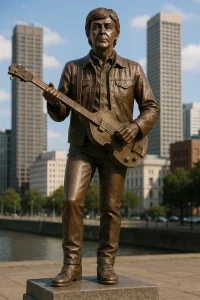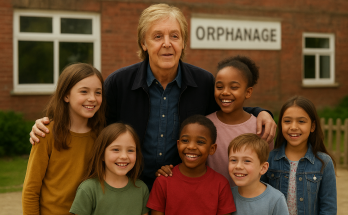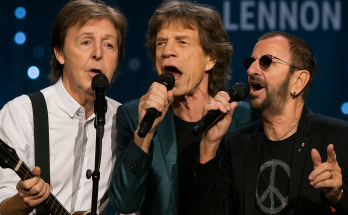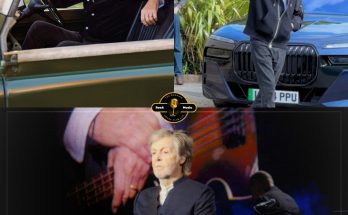Liverpool, England — The voice that helped define a generation, the songwriter who gave words and melody to the hopes and struggles of millions, and the artist who became a living symbol of peace and love — Paul McCartney — is about to be immortalized in bronze. Fans across the world have raised $2.8 million to erect a statue of the Beatles legend in the heart of Liverpool, the very city where his journey began.
From a Local Boy to a Global Legend

The statue will rise in central Liverpool, not far from the streets where a young Paul once wandered with a guitar slung over his back. Born in 1942, McCartney grew up in a modest working-class home, surrounded by the bustling sounds of a port city rebuilding itself after the war.
What started as youthful dreams in The Quarrymen, his first band with John Lennon, quickly turned into one of the most important revolutions in music history: The Beatles. With timeless songs and innovative sounds, they didn’t just conquer charts — they reshaped culture.
To many, a statue of Paul in Liverpool is more than a monument to one man. It is a reminder that greatness can be born in ordinary neighborhoods, nurtured by family, friendship, and resilience.
The Music That Defined Eras
For more than six decades, McCartney has been a creative force who never stopped evolving. His catalog is vast and diverse, spanning the innocence of “Love Me Do,” the haunting beauty of “Yesterday,” the anthem of unity in “Hey Jude,” and the spiritual comfort of “Let It Be.”
These songs are not just classics; they are woven into the fabric of human experience. Yesterday is one of the most covered songs in history, Hey Jude became a universal singalong of hope, and Let It Be has been sung at weddings, funerals, and moments of national mourning.
Even beyond The Beatles, McCartney proved unstoppable. With Wings and as a solo artist, he continued to deliver hits, tours, and collaborations that stretched across generations. His duets with artists like Stevie Wonder, Michael Jackson, and more recently Kanye West and Rihanna, bridged gaps between genres and eras.
Fans Lead the Way
The $2.8 million raised for the statue did not come from corporations or governments, but from fans across the globe.
Donations poured in from every corner of the world: from baby boomers who saw the Beatles play live in the 1960s, to teenagers who discovered the band through streaming services just last year.
Tribute concerts in London, New York, Tokyo, and São Paulo funneled money toward the project. Online campaigns brought together fans who may never meet in person but share an unshakable bond through McCartney’s music.
“Paul doesn’t just sing — he tells the story of humanity,” one middle-aged fan explained. “This statue will ensure that future generations remember the artist who carried music beyond borders and time.”
Why Liverpool Matters
Placing the statue in Liverpool carries deep symbolism. It is not just Paul McCartney’s birthplace — it is the birthplace of The Beatles, and by extension, the birthplace of modern pop culture as we know it.
For the people of Liverpool, this statue will be more than a tourist attraction. It will be a reflection of their city’s identity, resilience, and pride. The Beatles put Liverpool on the world map, and Paul McCartney remains one of its most famous sons.
Local officials have described the statue as a gift both to the city and to the millions of visitors who come each year to walk the same streets that inspired Penny Lane and Strawberry Fields Forever.
The Global Reaction
News of the statue has already made headlines around the world. Music critics, historians, and fellow musicians have applauded the move as long overdue.
“Paul McCartney is not just a musician,” one critic wrote. “He is a cultural treasure. His songs belong in history books as much as they belong on playlists.”
Younger artists, too, have paid tribute. Many describe McCartney as the blueprint for what it means to be a songwriter — blending melody, storytelling, and emotion in ways that remain unmatched.
More Than Stone and Bronze
The statue itself, sculpted in bronze, will depict McCartney with his guitar, mid-stride, as though walking through Liverpool on his way to yet another performance. But the meaning will stretch far beyond the physical form.
It represents permanence in a world where fame is fleeting. It assures fans that McCartney’s contribution to music and culture is not just passing entertainment but something eternal.
For those who have lived with his music as a companion through heartbreak, joy, war, peace, youth, and age, the monument will serve as a gathering place — a reminder that they are part of something bigger.
A Legacy That Lives On
Paul McCartney is now in his 80s, but he continues to perform sold-out stadium tours around the world. His energy on stage defies time, his voice still carries warmth, and his presence still inspires awe.
Unlike many artists of his generation, he has remained relevant, admired not only for what he achieved in the 1960s but for how he continues to evolve. His concerts attract three generations of fans: grandparents, parents, and children all singing Hey Jude together.
The statue, then, is not just a recognition of what McCartney has done, but of what he still represents — unity, creativity, and hope.
Closing Reflection
In a world that often feels divided, Paul McCartney’s music continues to bring people together. The decision to immortalize him in his hometown of Liverpool is more than a tribute to an individual; it is a tribute to music’s power to shape culture, inspire dreams, and give voice to humanity itself.
When the bronze figure of Paul McCartney rises in the heart of Liverpool, fans from around the world will gather. They will bring flowers, guitars, and memories. They will sing Yesterday, Let It Be, and Hey Jude in the streets where those dreams were first born.
And they will know, looking up at the statue, that Paul McCartney’s legacy is not just carved in stone, but in the hearts of millions.
Because Paul McCartney is not only part of music history.
He is music history.



